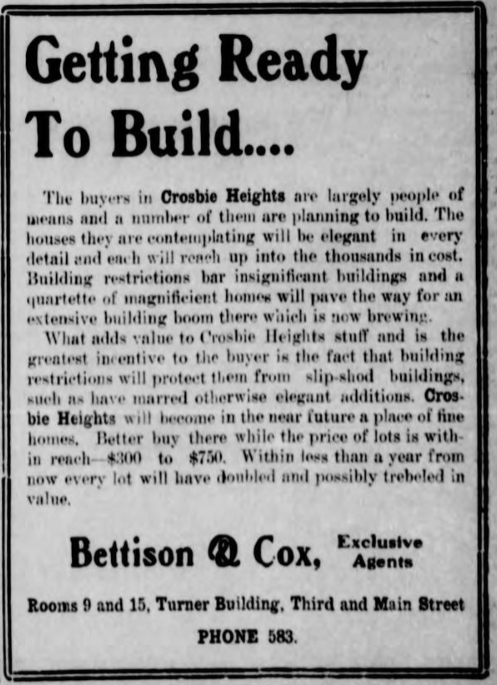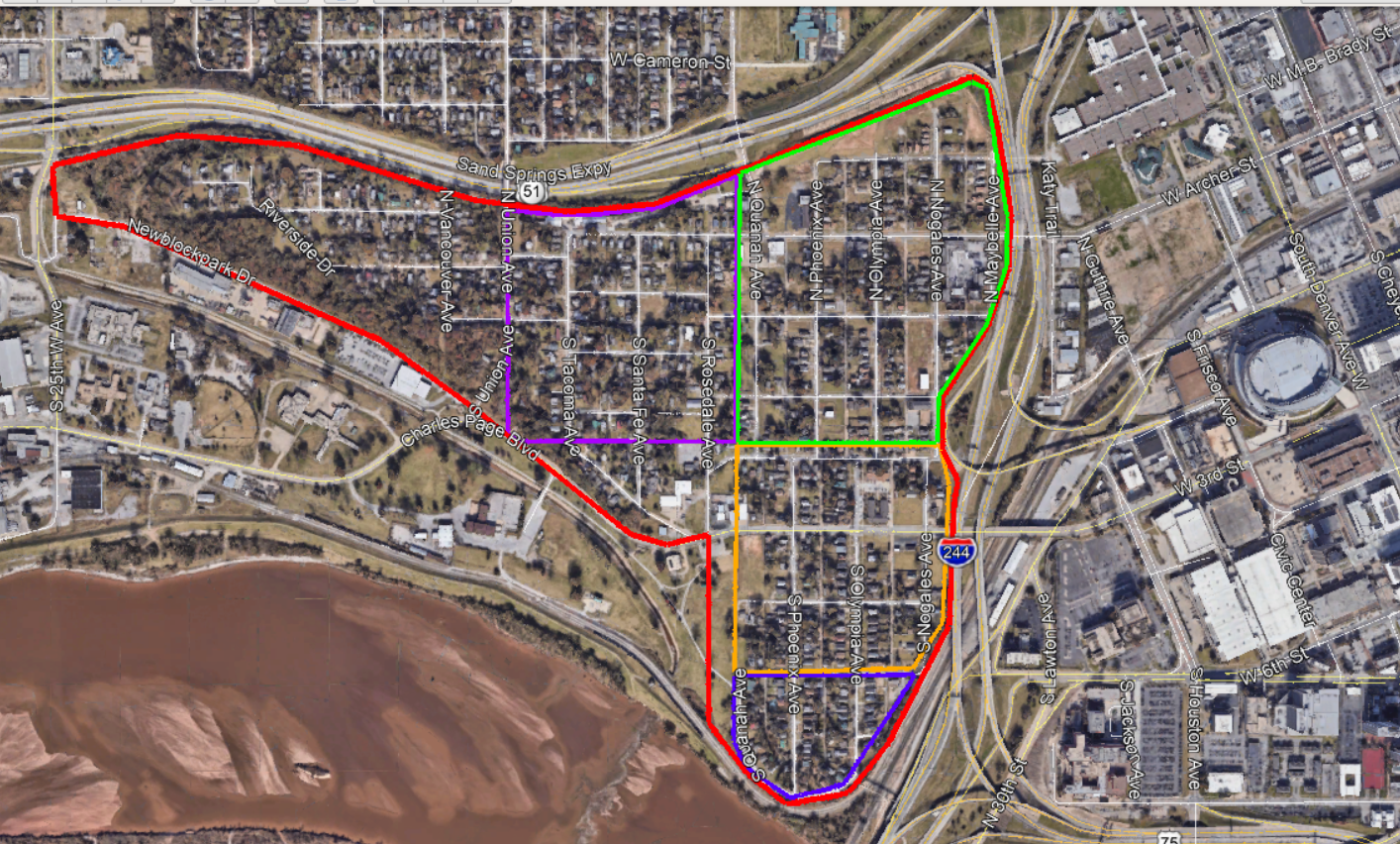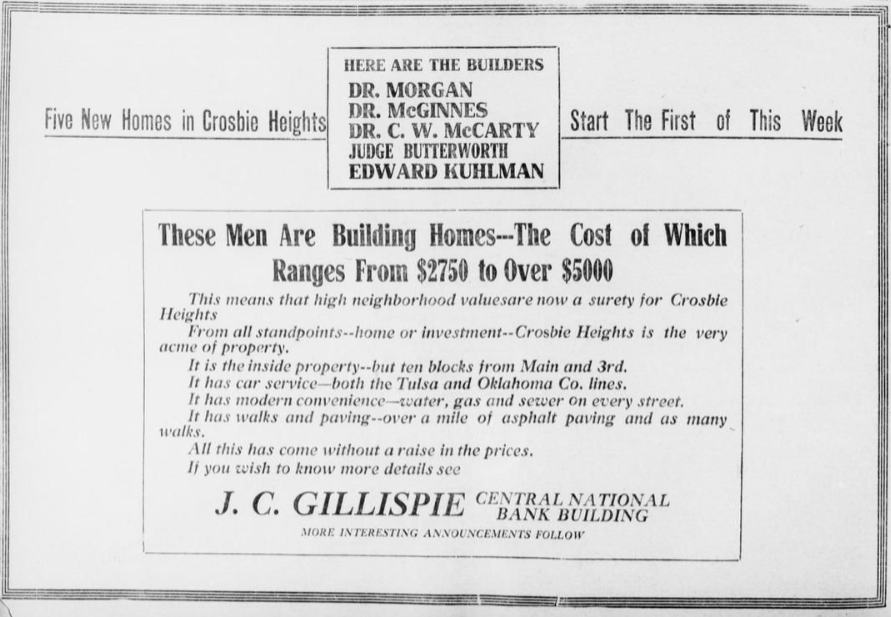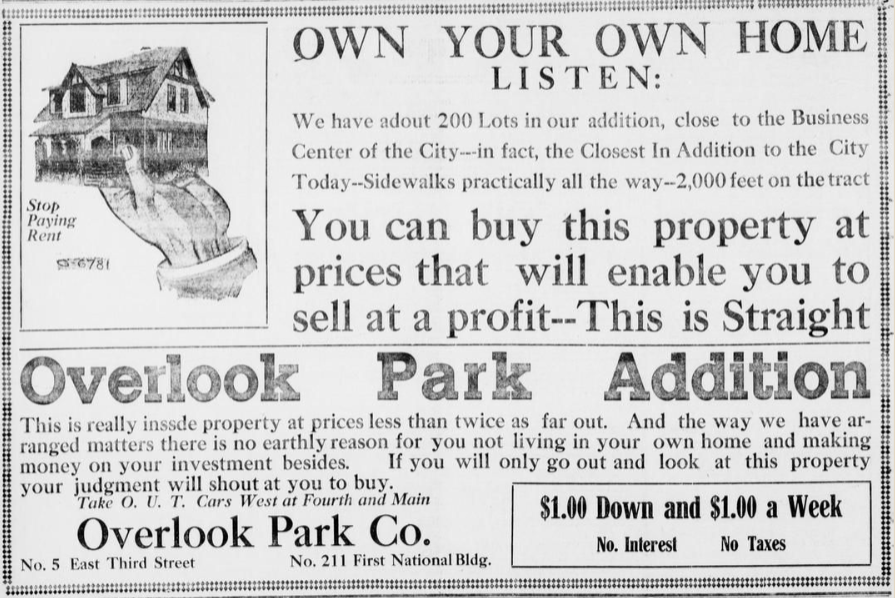Crosbie Heights neighborhood threatened by blight claim, slashed property values

Homeowners in a revitalizing historic neighborhood west of downtown Tulsa are feeling threatened by a sudden drop in the County Assessor's valuation of their lots and the persistent interest of the Tulsa Development Authority, the agency that seeks "blighted" property for redevelopment.
The Crosbie Heights neighborhood is comprised of several early Tulsa subdivisions. Roughly speaking, the neighborhood extends from the west leg of the Inner Dispersal Loop west to 25th West Avenue (Gilcrease Museum Road), and from the Sand Springs Expressway (US 412, US 64, OK 51) south to Charles Page Boulevard and the Arkansas River.
Last fall, property owners in the Crosbie Heights neighborhood started to notice that the value of their property, as determined by the Tulsa County Assessor's Office, had decreased, despite home sales in the area that indicated increasing market value for the neighborhood. Specifically, the value of unimproved land -- what a lot would be worth if there were no building on it -- was cut from as high as $19,563, but typically closer to $7,500, to a nearly uniform $3,000.
Crosbie Heights home owner Fletcher Stewart began to investigate. He and neighbors went through the Tulsa County Assessor's website, tabulating property values for every lot in the four largest subdivisions (Crosbie Heights, Mitchell-Crosbie, Overlook Park, and Owen Addition) in the neighborhood, and saw a disturbing pattern. According to the neighborhood's tabulations, values for 69 of 125 properties in Owen Addition and 6 of 9 properties in Overlook Park subdivision owned by Quapaw Investments LLC dropped to $3,000 in 2018; in 2019 the same drop was applied to nearly every other property in those two subdivisions plus the Crosbie Heights subdivision proper. (Lot values in the southernmost subdivision of the neighborhood, Mitchell-Crosbie, south of 7th Street along Nogales, Olympia, and Phoenix Avenues, were not similarly affected.) Stewart made open-records requests for assessment appeals and verified that Quapaw Investments LLC had protested the assessment on many of its properties in 2018.
On January 1, 2020, KTUL ran a news story on the Crosbie Heights land value situation, talking to Fletcher Stewart, Tulsa County Assessor John Wright, and the Tulsa City Councilor for the neighborhood, Kara Joy McKee.
At the last Tulsa City Council meeting before Christmas, on December 18, 2019, he presented his findings during the untelevised public comments period. He kindly provided me with his prepared remarks to publish here at BatesLine. I'll add some comments and further background info at the end.
My name is Fletcher Stewart, I own my home in Crosbie Heights, which is the neighborhood that immediately borders downtown to the west. It is one of Tulsa's oldest neighborhoods, we have some amazing views of the skyline, and easy walkability to the BOK Center and Tulsa Arts District. I love where I live and wouldn't want to be anywhere else. But according to the City and County, ours is a blighted neighborhood and our homes sit on virtually worthless land. There is a lot of fear among the neighbors about the future of the neighborhood, and the facts I'm going to present will show why those fears are valid.First, I want to bring attention to what has happened to property values, as assessed by the county. In Crosbie Heights, there is a developer who, according to my math, owns about 22 percent of the total lots. In 2018, he protested the land values for dozens of his properties. Regardless of the size of the lot, or the previous land value, the protests he submitted stated the land values should be dropped to $3,000. The assessor's office essentially rubber-stamped agreement to the protests and lowered the values. In 2019, because of the protests filed, this new land value was applied to most of the other properties in the neighborhood, leading to dramatic drops. I compiled a spreadsheet with data from the tax assessor that catalogues the property values over the last three years, and the results are shocking. The land my home sits on dropped in value from $7,600 in 2018 to $3,000 in 2019. I found a property that dropped from $18,000 to $3,000. Over and over and without variation, $3,000 is what the county says our land is worth, regardless of lot size, previous year value, or even if a sale had taken place recently.
I want to emphasize how abnormal this is. I could not find any other neighborhoods in Tulsa County with a similar pattern of land values. In fact, I can say confidently that Crosbie Heights has the lowest average land values anywhere in the county, and I've been looking. I have looked at neighborhoods all over: Turley, West Tulsa, the homes in the Pearl that are facing Eminent Domain. I even searched for news articles to see what neighborhoods had experienced multiple shootings and homicides, and even those had higher land values than our downtown adjacent homes.
The other pressing issue that must be addressed is the Crosbie Heights Blight Study. Without preamble or outreach to the neighbors, the Tulsa Development Authority commissioned the Blight Study. Its stated purpose is not to determine if Crosbie Heights is blighted, but simply to "document blight conditions" on the neighborhood. It concludes, after several pages of images of boarded up houses, that Crosbie Heights is indeed blighted, and "is detrimental to public health, safety, morals and welfare of the city." This study provides no recommendations, nor path to rehabilitate the neighborhood; it just lists and describes the conditions of blight.
Now the term blight carries real weight as a legal term. Being labeled blighted means the city may now exercise Eminent Domain and acquire our homes. With that in mind, just across the highway that separates us from downtown, there is an unprecedented boom in development and vibrancy. The BOK Center, Drillers Stadium and other recent developments brings thousands to the heart of the city. There is so much more planned, the next few years will bring in even more growth to downtown - so why does the vitality end at the IDL?
There has been so much discussion lately about affordable housing in Tulsa. Well that's us - our neighborhood is affordable downtown housing. Why are we the subject of a blight study, and not part of the conversation about affordable housing and our place in it?
Here's the writing on the wall, the extrapolation of the facts I presented, and the reason I'm scared: Over the next few years. Our neighborhood will deteriorate. The falling values will scare off investment, and will make it easy for developers to acquire property, clear the houses on them, and sit on the vacant lots. At some point in the near future a plan will be presented. My guess would be high-rise condos, sold on skyline views and close access to downtown. The city, which has already made the determination the area is blighted, will exercise its power of Eminent Domain to clear the remaining homes- and that will be it. Some people will probably make a bunch of money, but it won't be us, the residents of the neighborhood. We'll lose our homes, and with them, Tulsa will lose another piece of its past.
I'm here to ask the city for help. Publicly disavow the blight study, and make a commitment to the downtown neighborhoods regarding future use of Eminent Domain. Work with us so the booming success of downtown is felt by more Tulsans, and the vitality doesn't just end at the IDL.
As you can see from the 1908 and 1911 newspaper ads in this entry, these subdivisions were prestigious locations when built. Developers were keen to let the public know that prominent and prosperous members of the public were building homes in the area, and that covenants would ensure that only quality homes were built. Proximity and strong connections to downtown (both streetcar companies and the Sand Springs interurban served the neighborhood) were major selling points. Homes of similar vintage and quality in other Tulsa neighborhoods are under Historic Preservation zoning protection.
As Mr. Stewart notes, in 2018, the Tulsa Development Authority conducted a "blight study" of the Crosbie Heights neighborhood. The blight study turned its survey of resident requests for improvements into a justification for a finding of blight, which would open the door for forcible acquisition by eminent domain. On March 27, 2019, the TDA asked the City Council to ratify its finding of blight, prompting strong protests from residents, which led the City Council not to act on the TDA's recommendations.
Oklahoma has a ridiculously loose definition of blight. Nearly any piece of property could qualify. If a city council makes a finding of blight, the courts generally defer. The Castle Coalition, a project of the Institute for Justice, has given Oklahoma an F for its failure to protect property rights because of this loose definition of blight. Here is the definition in 11 O.S. 38-101, part of the Oklahoma Municipal Code:
"Blighted area" shall mean an area in which there are properties, buildings, or improvements, whether occupied or vacant, whether residential or nonresidential, which by reason of dilapidation, deterioration, age or obsolescence, inadequate provision for ventilation, light, air, sanitation or open spaces; improper subdivision or obsolete platting of land; deterioration or demolition of structures without repair, replacement or reinvestment; improper street layout in terms of existing or projected traffic needs, traffic congestion or lack of parking or terminal facilities needed for existing or proposed land uses in the area, predominance of defective or inadequate street layouts; faulty lot layout in relation to size, adequacy, accessibility or usefulness; insanitary or unsafe conditions, deterioration of site or other improvements; diversity of ownership, tax or special assessment delinquency exceeding the fair value of the land; defective or unusual conditions of title including, but not limited to, highly fragmented interests; any one or combination of such conditions which the municipal governing body determines substantially impairs or arrests the sound growth of the municipality and constitutes a substantial liability, or which endangers life or property by fire or other causes, or is conducive to ill health, transmission of disease, mortality, juvenile delinquency, or crime and by reason thereof, is detrimental to the public health, safety, morals or welfare;
11 O.S. 38-102 makes a legislative finding that condemning a blighted area is a public use, presumably to satisfy Article 2, Section 23, of the Oklahoma Constitution, which limits eminent domain to public use, as opposed to public purpose or public benefit. 11 O.S. 38-103 authorizes a municipality to take blighted properties. 11 O.S. 38-105 requires a municipality's governing body to make a finding of blight before the condemnations can begin. Similar provisions in Title 27, Article 5, govern a county's use of eminent domain.
Although in 2006 the Oklahoma Supreme Court in Board of County Commissioners of Muskogee County v. Lowery (2006 OK 31) affirmed the Oklahoma Constitution's prohibition of condemnation for economic development, a tighter standard than the U. S. Supreme Court applied in Kelo v. New London, they added a qualification that left an enormous loophole, enabling corrupt politicians to continue to seize private property for the benefit of their friends:
We further hold that takings for the purpose of economic development alone (not in connection with the removal of blighted property) do not constitute a public use or public purpose to support the exercise of eminent domain as a matter of Oklahoma constitutional law, nor does it satisfy the public purpose requirement of 27 O.S. 2001 § 5.
This is not the first time that the Crosbie Heights neighborhood has been threatened with eminent domain. Back in 2000, during the second failed attempt to assemble a package of projects that would convince voters to raise taxes for an arena, there was discussion about adding some form of "river development" as a sweetener for voters, and Crosbie Heights south of 3rd Street was targeted for replacement with an entertainment district / amusement park -- "Tulsa's Six Flags," as one proponent called it. Raising a public alarm caused the idea to be shelved.
More about that later, but as I wrote at the time, "It's never too early to stop a bad idea." The bulldozers aren't running yet, the Council hasn't yet acted on the TDA's requested blight declaration, but there are worrying signs that someone is trying to line everything up to clear this historic neighborhood for private redevelopment. We must remain vigilant.
0 TrackBacks
Listed below are links to blogs that reference this entry: Crosbie Heights neighborhood threatened by blight claim, slashed property values.
TrackBack URL for this entry: https://www.batesline.com/cgi-bin/mt/mt-tb.cgi/8610


